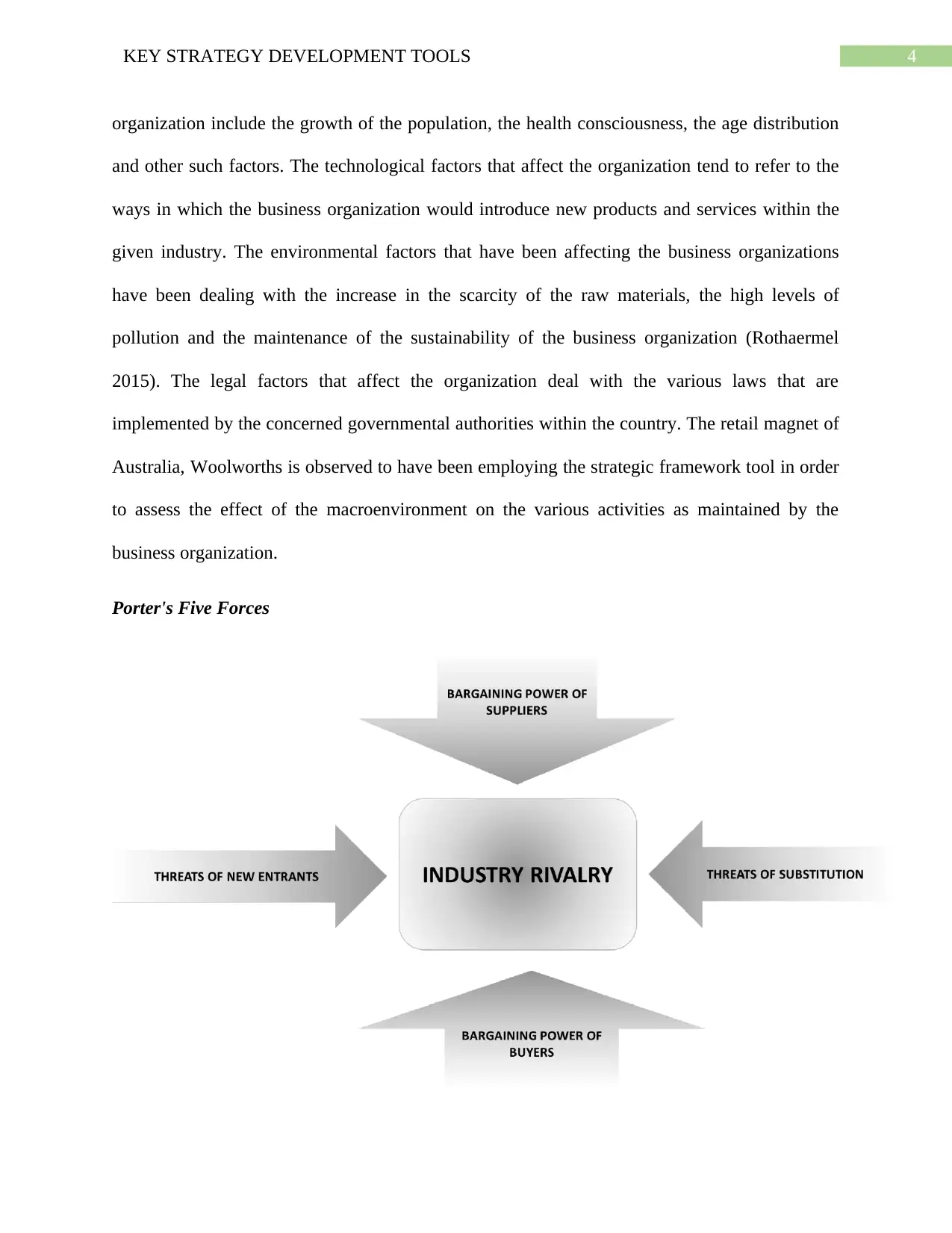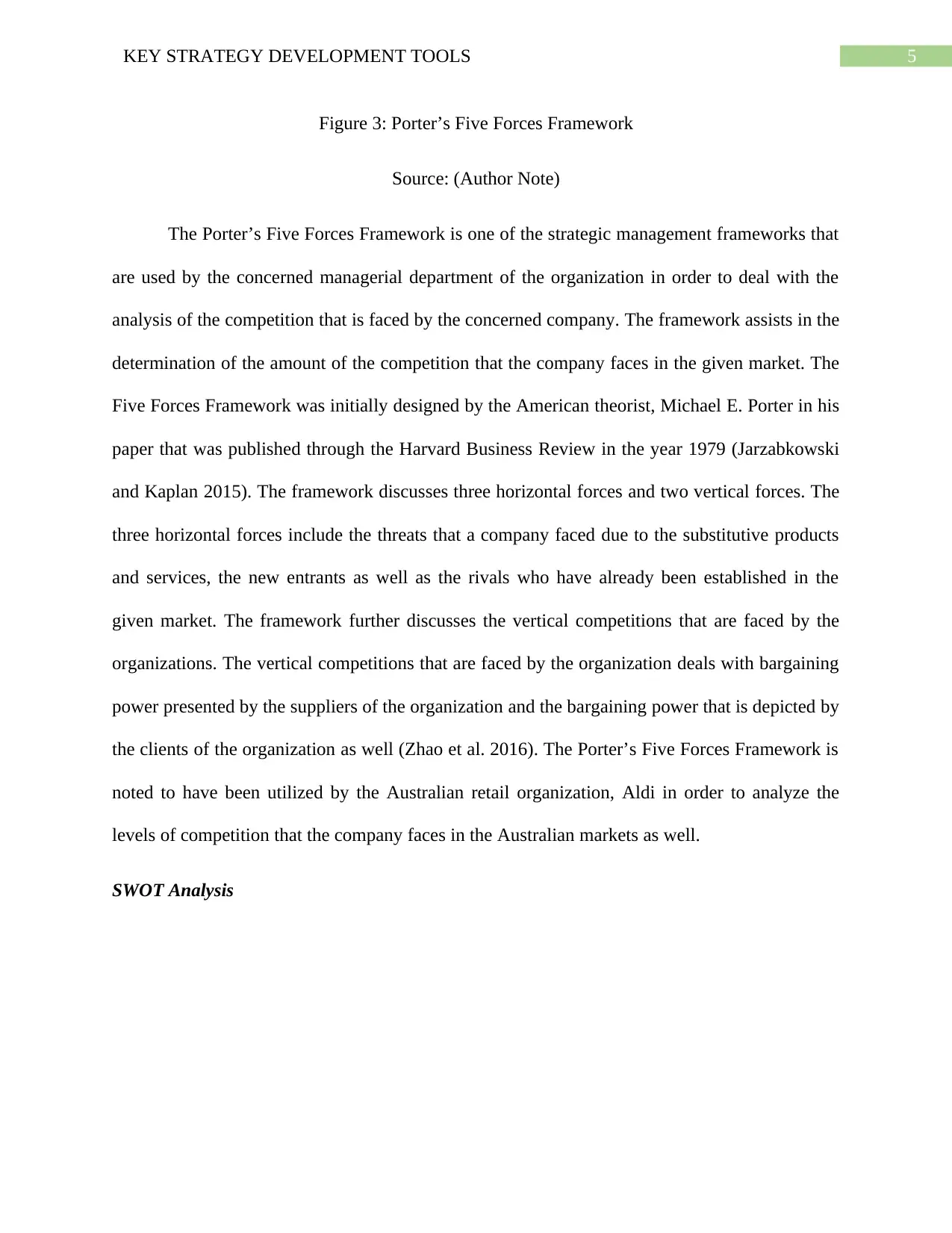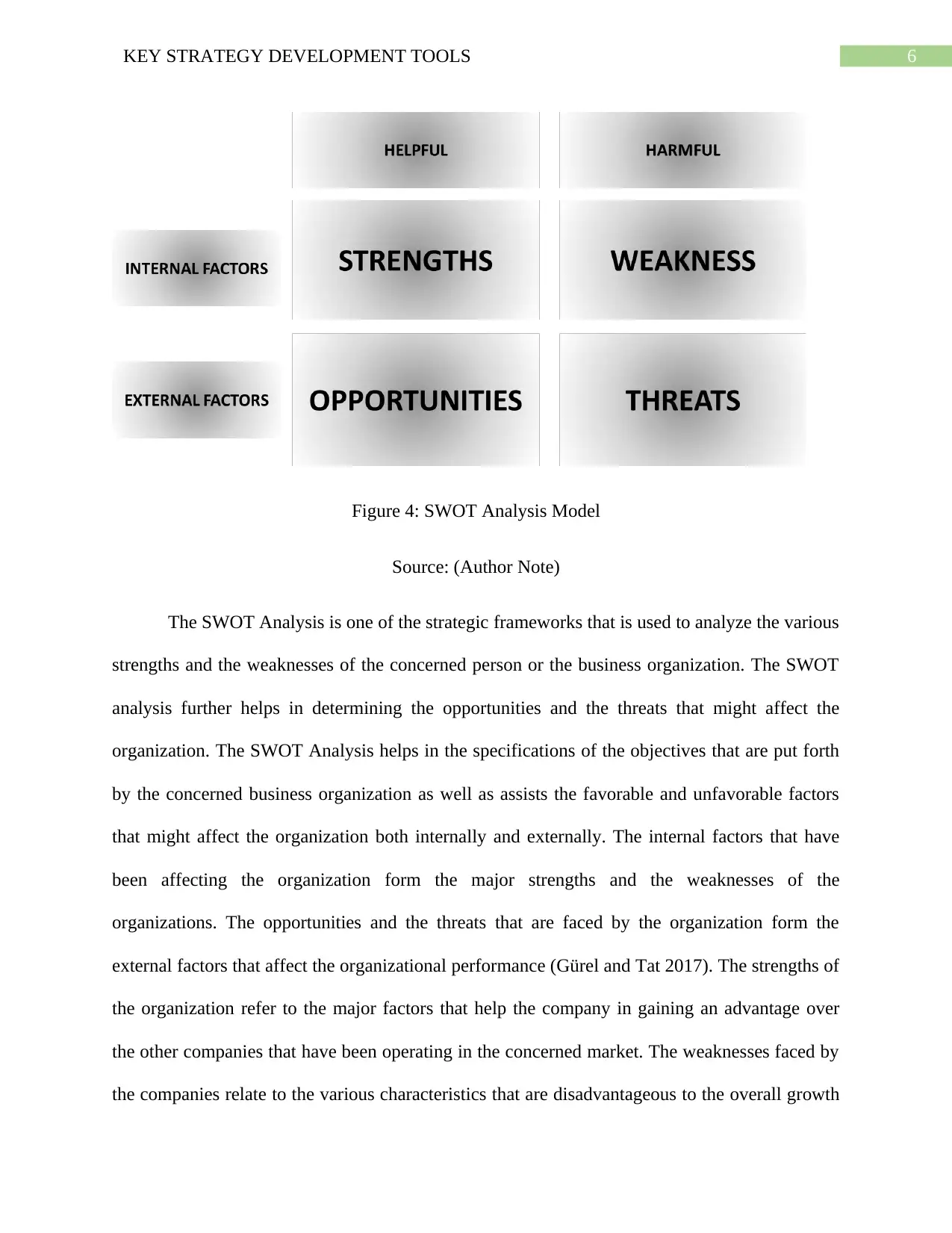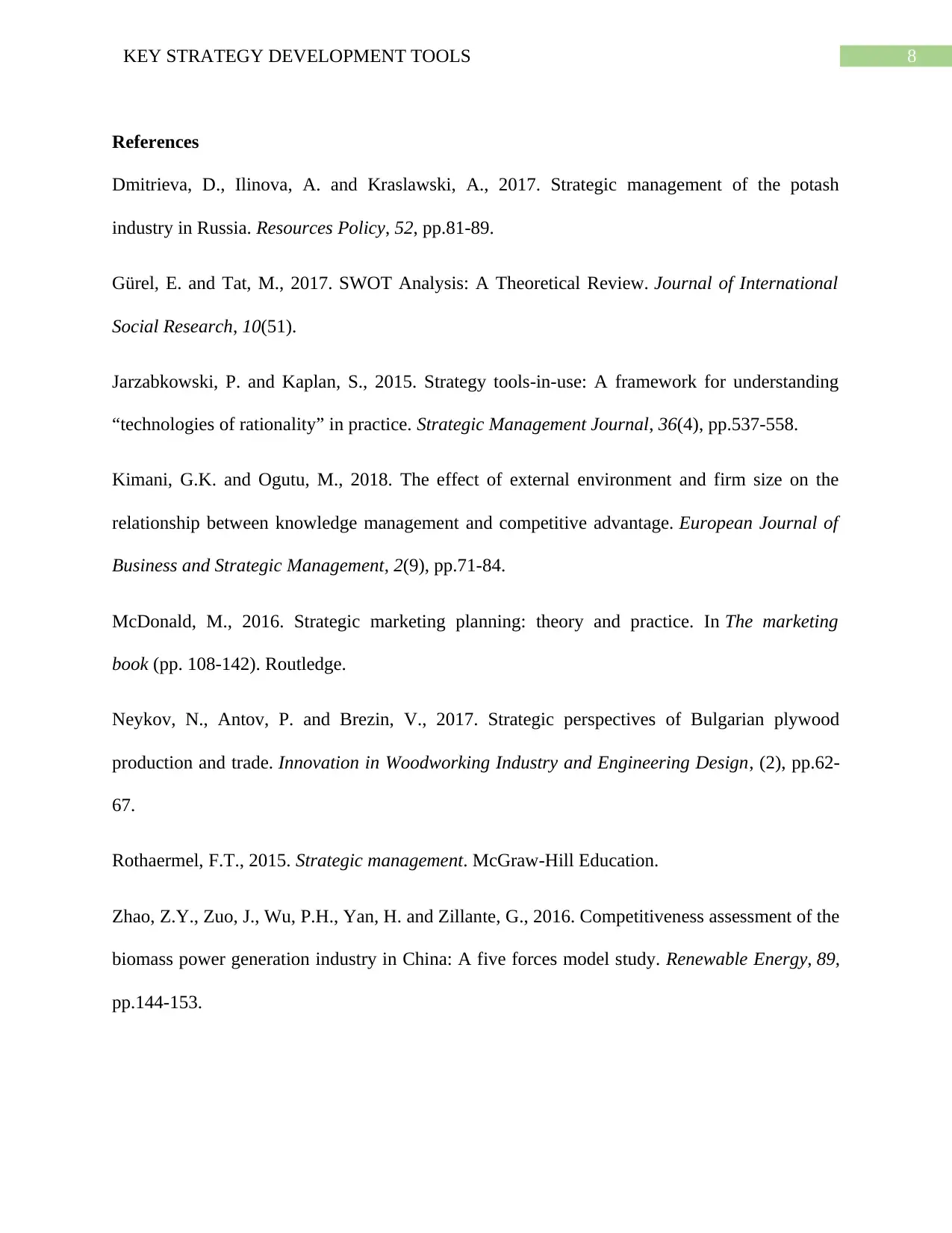Strategic Tools: Ansoff Matrix, PESTEL, Porter's Five Forces, SWOT
VerifiedAdded on 2023/01/24
|9
|1631
|73
Essay
AI Summary
This essay provides an in-depth exploration of four key strategic development tools: the Ansoff Matrix, PESTEL Analysis, Porter's Five Forces Framework, and SWOT Analysis. The essay begins by explaining the Ansoff Matrix, detailing how it aids in devising growth strategies through market penetration, market development, product development, and diversification. The PESTEL Analysis is then discussed, emphasizing its role in assessing macroenvironmental factors such as political, economic, social, technological, environmental, and legal influences on a business. The essay proceeds to analyze Porter’s Five Forces Framework, illustrating how it helps in understanding competitive landscapes and determining the intensity of competition. Finally, the SWOT Analysis is presented, highlighting its use in evaluating an organization’s internal strengths and weaknesses, as well as external opportunities and threats. The essay references real-world examples, such as ANZ Bank, Woolworths, Aldi, and Myers, to demonstrate the practical application of these strategic tools. In conclusion, the essay underscores the importance of these tools in driving overall business growth through a comprehensive analysis of both internal and external environments, aiding in informed decision-making and strategic planning.

Running head: KEY STRATEGY DEVELOPMENT TOOLS
KEY STRATEGY DEVELOPMENT TOOLS
Name of the Student
Name of the University
Author Note
KEY STRATEGY DEVELOPMENT TOOLS
Name of the Student
Name of the University
Author Note
Paraphrase This Document
Need a fresh take? Get an instant paraphrase of this document with our AI Paraphraser

1KEY STRATEGY DEVELOPMENT TOOLS
Introduction
The following essay sheds light on the four major approaches towards strategic
management. The essay opens with a discussion on the Ansoff Matrix that is implemented by the
business organization to devise the strategies that would assist the future growth of the business
organizations. the essay thereafter discusses the PESTEL Analysis model that is used to analyze
the macroenvironment of a business. The essay proceeds further to discuss the Porter’s Five
Forces Framework and the SWOT Analysis model used for analyzing the microenvironment of a
business firm.
Ansoff Matrix
Figure 1: Ansoff Matrix
Source: (Author note)
Ansoff matrix is a tool that is used for the strategic planning within the business
organizations. The tool is helpful for devising the strategies that would assist the future growth of
Introduction
The following essay sheds light on the four major approaches towards strategic
management. The essay opens with a discussion on the Ansoff Matrix that is implemented by the
business organization to devise the strategies that would assist the future growth of the business
organizations. the essay thereafter discusses the PESTEL Analysis model that is used to analyze
the macroenvironment of a business. The essay proceeds further to discuss the Porter’s Five
Forces Framework and the SWOT Analysis model used for analyzing the microenvironment of a
business firm.
Ansoff Matrix
Figure 1: Ansoff Matrix
Source: (Author note)
Ansoff matrix is a tool that is used for the strategic planning within the business
organizations. The tool is helpful for devising the strategies that would assist the future growth of

2KEY STRATEGY DEVELOPMENT TOOLS
the business organizations. The major people who have been benefitting from the utilization of
the model are those who have been serving in the managerial levels within the organization. The
concept of the Ansoff Matrix was introduced by the celebrated Russian American business
manager and applied mathematician Igor Ansoff (Dmitrieva, Ilinova and Kraslawski 2017). He
had described four major growth strategies that are generally followed by the business
organizations in order to depict a proper growth of the business organization in the given market.
The four major growth alternatives are market penetration, market development, product
development and diversification. The market penetration strategy helps the concerned company
to put forth an increment in the market share of the company in the given markets. The market
development is helpful in the expansion of the company in the newer markets with the help of
the products that the company has been manufacturing. The third step involves the development
of the products in order to improve the market hold of the company in the given markets
(Neykov, Antov and Brezin 2017). The fourth style refers to the ways wherein the company
attempts an entry into the newer markets through the introduction of the newer products. This
strategy is found to have been adopted by the ANZ Bank for growing into the international
markets.
PESTEL Analysis
the business organizations. The major people who have been benefitting from the utilization of
the model are those who have been serving in the managerial levels within the organization. The
concept of the Ansoff Matrix was introduced by the celebrated Russian American business
manager and applied mathematician Igor Ansoff (Dmitrieva, Ilinova and Kraslawski 2017). He
had described four major growth strategies that are generally followed by the business
organizations in order to depict a proper growth of the business organization in the given market.
The four major growth alternatives are market penetration, market development, product
development and diversification. The market penetration strategy helps the concerned company
to put forth an increment in the market share of the company in the given markets. The market
development is helpful in the expansion of the company in the newer markets with the help of
the products that the company has been manufacturing. The third step involves the development
of the products in order to improve the market hold of the company in the given markets
(Neykov, Antov and Brezin 2017). The fourth style refers to the ways wherein the company
attempts an entry into the newer markets through the introduction of the newer products. This
strategy is found to have been adopted by the ANZ Bank for growing into the international
markets.
PESTEL Analysis
⊘ This is a preview!⊘
Do you want full access?
Subscribe today to unlock all pages.

Trusted by 1+ million students worldwide

3KEY STRATEGY DEVELOPMENT TOOLS
Figure 2: PESTEL Analysis
Source: (Author Note)
The PESTEL Analysis is used to describe as well as discuss the macroenvironmental
factors that affect the business. The PESTEL analysis is used to analyze the various external
factors that affect the business. The majority of the issues that are presented by the external
environments of a certain business can be analyzed through the implementation of the PESTEL
Analysis model. The model consists of six different factors, the political, economic, social,
technological, environmental and legal factors. The political factors that affect the business
might refer to the degree of intervention of the governmental bodies within the operations of the
business organization (Kimani and Ogutu 2018). The economic factors that have been affecting
the organization include the economic growth, the rates of interest, the rates of exchange as well
as the rates of inflation within the given organization. The social factors that affect the
Figure 2: PESTEL Analysis
Source: (Author Note)
The PESTEL Analysis is used to describe as well as discuss the macroenvironmental
factors that affect the business. The PESTEL analysis is used to analyze the various external
factors that affect the business. The majority of the issues that are presented by the external
environments of a certain business can be analyzed through the implementation of the PESTEL
Analysis model. The model consists of six different factors, the political, economic, social,
technological, environmental and legal factors. The political factors that affect the business
might refer to the degree of intervention of the governmental bodies within the operations of the
business organization (Kimani and Ogutu 2018). The economic factors that have been affecting
the organization include the economic growth, the rates of interest, the rates of exchange as well
as the rates of inflation within the given organization. The social factors that affect the
Paraphrase This Document
Need a fresh take? Get an instant paraphrase of this document with our AI Paraphraser

4KEY STRATEGY DEVELOPMENT TOOLS
organization include the growth of the population, the health consciousness, the age distribution
and other such factors. The technological factors that affect the organization tend to refer to the
ways in which the business organization would introduce new products and services within the
given industry. The environmental factors that have been affecting the business organizations
have been dealing with the increase in the scarcity of the raw materials, the high levels of
pollution and the maintenance of the sustainability of the business organization (Rothaermel
2015). The legal factors that affect the organization deal with the various laws that are
implemented by the concerned governmental authorities within the country. The retail magnet of
Australia, Woolworths is observed to have been employing the strategic framework tool in order
to assess the effect of the macroenvironment on the various activities as maintained by the
business organization.
Porter's Five Forces
organization include the growth of the population, the health consciousness, the age distribution
and other such factors. The technological factors that affect the organization tend to refer to the
ways in which the business organization would introduce new products and services within the
given industry. The environmental factors that have been affecting the business organizations
have been dealing with the increase in the scarcity of the raw materials, the high levels of
pollution and the maintenance of the sustainability of the business organization (Rothaermel
2015). The legal factors that affect the organization deal with the various laws that are
implemented by the concerned governmental authorities within the country. The retail magnet of
Australia, Woolworths is observed to have been employing the strategic framework tool in order
to assess the effect of the macroenvironment on the various activities as maintained by the
business organization.
Porter's Five Forces

5KEY STRATEGY DEVELOPMENT TOOLS
Figure 3: Porter’s Five Forces Framework
Source: (Author Note)
The Porter’s Five Forces Framework is one of the strategic management frameworks that
are used by the concerned managerial department of the organization in order to deal with the
analysis of the competition that is faced by the concerned company. The framework assists in the
determination of the amount of the competition that the company faces in the given market. The
Five Forces Framework was initially designed by the American theorist, Michael E. Porter in his
paper that was published through the Harvard Business Review in the year 1979 (Jarzabkowski
and Kaplan 2015). The framework discusses three horizontal forces and two vertical forces. The
three horizontal forces include the threats that a company faced due to the substitutive products
and services, the new entrants as well as the rivals who have already been established in the
given market. The framework further discusses the vertical competitions that are faced by the
organizations. The vertical competitions that are faced by the organization deals with bargaining
power presented by the suppliers of the organization and the bargaining power that is depicted by
the clients of the organization as well (Zhao et al. 2016). The Porter’s Five Forces Framework is
noted to have been utilized by the Australian retail organization, Aldi in order to analyze the
levels of competition that the company faces in the Australian markets as well.
SWOT Analysis
Figure 3: Porter’s Five Forces Framework
Source: (Author Note)
The Porter’s Five Forces Framework is one of the strategic management frameworks that
are used by the concerned managerial department of the organization in order to deal with the
analysis of the competition that is faced by the concerned company. The framework assists in the
determination of the amount of the competition that the company faces in the given market. The
Five Forces Framework was initially designed by the American theorist, Michael E. Porter in his
paper that was published through the Harvard Business Review in the year 1979 (Jarzabkowski
and Kaplan 2015). The framework discusses three horizontal forces and two vertical forces. The
three horizontal forces include the threats that a company faced due to the substitutive products
and services, the new entrants as well as the rivals who have already been established in the
given market. The framework further discusses the vertical competitions that are faced by the
organizations. The vertical competitions that are faced by the organization deals with bargaining
power presented by the suppliers of the organization and the bargaining power that is depicted by
the clients of the organization as well (Zhao et al. 2016). The Porter’s Five Forces Framework is
noted to have been utilized by the Australian retail organization, Aldi in order to analyze the
levels of competition that the company faces in the Australian markets as well.
SWOT Analysis
⊘ This is a preview!⊘
Do you want full access?
Subscribe today to unlock all pages.

Trusted by 1+ million students worldwide

6KEY STRATEGY DEVELOPMENT TOOLS
Figure 4: SWOT Analysis Model
Source: (Author Note)
The SWOT Analysis is one of the strategic frameworks that is used to analyze the various
strengths and the weaknesses of the concerned person or the business organization. The SWOT
analysis further helps in determining the opportunities and the threats that might affect the
organization. The SWOT Analysis helps in the specifications of the objectives that are put forth
by the concerned business organization as well as assists the favorable and unfavorable factors
that might affect the organization both internally and externally. The internal factors that have
been affecting the organization form the major strengths and the weaknesses of the
organizations. The opportunities and the threats that are faced by the organization form the
external factors that affect the organizational performance (Gürel and Tat 2017). The strengths of
the organization refer to the major factors that help the company in gaining an advantage over
the other companies that have been operating in the concerned market. The weaknesses faced by
the companies relate to the various characteristics that are disadvantageous to the overall growth
Figure 4: SWOT Analysis Model
Source: (Author Note)
The SWOT Analysis is one of the strategic frameworks that is used to analyze the various
strengths and the weaknesses of the concerned person or the business organization. The SWOT
analysis further helps in determining the opportunities and the threats that might affect the
organization. The SWOT Analysis helps in the specifications of the objectives that are put forth
by the concerned business organization as well as assists the favorable and unfavorable factors
that might affect the organization both internally and externally. The internal factors that have
been affecting the organization form the major strengths and the weaknesses of the
organizations. The opportunities and the threats that are faced by the organization form the
external factors that affect the organizational performance (Gürel and Tat 2017). The strengths of
the organization refer to the major factors that help the company in gaining an advantage over
the other companies that have been operating in the concerned market. The weaknesses faced by
the companies relate to the various characteristics that are disadvantageous to the overall growth
Paraphrase This Document
Need a fresh take? Get an instant paraphrase of this document with our AI Paraphraser

7KEY STRATEGY DEVELOPMENT TOOLS
of the company. The opportunities that are faced by the organization refer to the factors that the
company might exploit in order to gain a proper advantage over the other companies in the
market. The threats that are faced by the company refer to the issues that might negatively affect
the company (McDonald 2016). A major example of the application of the SWOT Analysis is
demonstrated by the Australian retail chain, Myers.
Conclusion
Thus, from the above discussion it might safely be concluded that the various strategic
tools assist the overall growth of the company through the proper analysis of the external and the
internal environments that are faced by the company. The models and frameworks that have been
discussed above helps in the understanding of the trends that are followed by the companies that
are active within the given market.
of the company. The opportunities that are faced by the organization refer to the factors that the
company might exploit in order to gain a proper advantage over the other companies in the
market. The threats that are faced by the company refer to the issues that might negatively affect
the company (McDonald 2016). A major example of the application of the SWOT Analysis is
demonstrated by the Australian retail chain, Myers.
Conclusion
Thus, from the above discussion it might safely be concluded that the various strategic
tools assist the overall growth of the company through the proper analysis of the external and the
internal environments that are faced by the company. The models and frameworks that have been
discussed above helps in the understanding of the trends that are followed by the companies that
are active within the given market.

8KEY STRATEGY DEVELOPMENT TOOLS
References
Dmitrieva, D., Ilinova, A. and Kraslawski, A., 2017. Strategic management of the potash
industry in Russia. Resources Policy, 52, pp.81-89.
Gürel, E. and Tat, M., 2017. SWOT Analysis: A Theoretical Review. Journal of International
Social Research, 10(51).
Jarzabkowski, P. and Kaplan, S., 2015. Strategy tools‐in‐use: A framework for understanding
“technologies of rationality” in practice. Strategic Management Journal, 36(4), pp.537-558.
Kimani, G.K. and Ogutu, M., 2018. The effect of external environment and firm size on the
relationship between knowledge management and competitive advantage. European Journal of
Business and Strategic Management, 2(9), pp.71-84.
McDonald, M., 2016. Strategic marketing planning: theory and practice. In The marketing
book (pp. 108-142). Routledge.
Neykov, N., Antov, P. and Brezin, V., 2017. Strategic perspectives of Bulgarian plywood
production and trade. Innovation in Woodworking Industry and Engineering Design, (2), pp.62-
67.
Rothaermel, F.T., 2015. Strategic management. McGraw-Hill Education.
Zhao, Z.Y., Zuo, J., Wu, P.H., Yan, H. and Zillante, G., 2016. Competitiveness assessment of the
biomass power generation industry in China: A five forces model study. Renewable Energy, 89,
pp.144-153.
References
Dmitrieva, D., Ilinova, A. and Kraslawski, A., 2017. Strategic management of the potash
industry in Russia. Resources Policy, 52, pp.81-89.
Gürel, E. and Tat, M., 2017. SWOT Analysis: A Theoretical Review. Journal of International
Social Research, 10(51).
Jarzabkowski, P. and Kaplan, S., 2015. Strategy tools‐in‐use: A framework for understanding
“technologies of rationality” in practice. Strategic Management Journal, 36(4), pp.537-558.
Kimani, G.K. and Ogutu, M., 2018. The effect of external environment and firm size on the
relationship between knowledge management and competitive advantage. European Journal of
Business and Strategic Management, 2(9), pp.71-84.
McDonald, M., 2016. Strategic marketing planning: theory and practice. In The marketing
book (pp. 108-142). Routledge.
Neykov, N., Antov, P. and Brezin, V., 2017. Strategic perspectives of Bulgarian plywood
production and trade. Innovation in Woodworking Industry and Engineering Design, (2), pp.62-
67.
Rothaermel, F.T., 2015. Strategic management. McGraw-Hill Education.
Zhao, Z.Y., Zuo, J., Wu, P.H., Yan, H. and Zillante, G., 2016. Competitiveness assessment of the
biomass power generation industry in China: A five forces model study. Renewable Energy, 89,
pp.144-153.
⊘ This is a preview!⊘
Do you want full access?
Subscribe today to unlock all pages.

Trusted by 1+ million students worldwide
1 out of 9
Related Documents
Your All-in-One AI-Powered Toolkit for Academic Success.
+13062052269
info@desklib.com
Available 24*7 on WhatsApp / Email
![[object Object]](/_next/static/media/star-bottom.7253800d.svg)
Unlock your academic potential
Copyright © 2020–2025 A2Z Services. All Rights Reserved. Developed and managed by ZUCOL.





